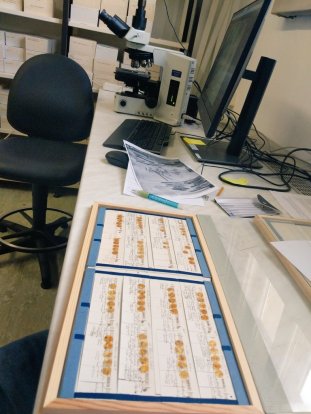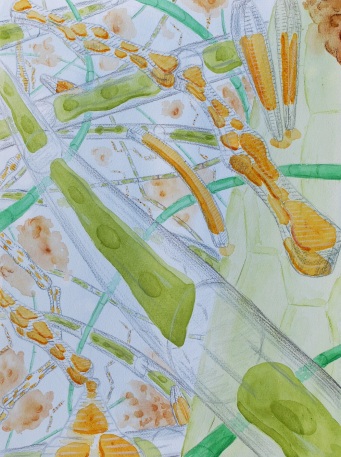
Images from E. César’s Tweet on the Ehrenberg Collection at the Museum für Naturkunde in Berlin.
Though I have more time to think deeply right now than ever in my life, I’m finding it difficult to do; everything is so different from usual that it’s unsettling. That’s why I’m not focusing on one topic for a month’s worth of posts as I usually do, but flitting from one topic to another from week to week. In part this is because of Twitter, my lifeline to the botanical world at the moment. Thank goodness botanists are interesting people and post interesting ideas. Most days I find at least one item worth bookmarking and then delving into more deeply. That’s how I discovered Christian Gottfried Ehrenberg (1795-1876). I must have come across his name in the past, especially when I was reading about Alexander von Humboldt because Ehrenberg accompanied the explorer on his trip to Siberia in 1829.
A Tweet on Ehrenberg by Edgley César, curator of diatoms at the Natural History Museum, London, included the image above. It was the photo on the upper right that first caught my eye—obviously old data—and the illustration on the lower left was another lure. César took the pictures at the Museum für Naturkunde in Berlin where he had spent a week examining specimens of a genus Ehrenberg had described and was amazed by how much work this “founding father” of diatom research had done and how well he drew. As the thread continued, someone asked about Ehrenberg and César pointed them, and me, to a series of papers published in 1998 dealing with his life, work, and collections.
Ehrenberg was definitely productive throughout his life. Born near Leipzig, he attended the university there, completing his doctorate on fungi in 1818. His fungal herbarium is in the Botanic Garden and Botanical Museum Berlin-Dahlem. From 1820-1825, Ehrenberg participated in an expedition to the Middle East, during which he and his friend Wilhelm Hemprich amassed 114 boxes with 46,000 plant and 34,000 animals specimens as well as seeds, fossils, minerals, and of course, mummies. Yet the trip was grueling, with three-quarters of team dying, including Hemprich. Ehrenberg published, Symbolae Physicae, a multivolume work on all aspects of the collection and including 800 plates, many based on his drawings. He did not describe many of the plants he collected and left the world of higher plants to concentrate on microscopic work, on what were called infusoria, organisms found in decaying matter. However, he did teach all his children to press plants and create their own herbaria.
A great deal of Ehrenberg’s research was on radiolaria and diatoms. He considered them all tiny animals and carefully studied their internal structures, which he interpreted as digestive, reproductive, and muscular. He thought that when better microscopes were developed, these organelles would be seen more clearly. It is interesting that when diatoms were finally recognized to be more closely related to plants than animals, interest in their internal structures waned, and their taxonomy became based primarily on their elaborate silicate shells that come in a dizzying array of patterns. The assumption became that there was little difference among these organisms internally; plant cell structures were just not that interesting. Ancient shells found in diatomaceous earth have long been used in geological exploration, since they are related to oil deposits, but even present-day species are often dried, and just their shells examined.
Ehrenberg made extremely detailed and exquisite illustrations of these organisms and in 1838 published a book with 64 plates on Infusoria in all of their complexity. He also kept detailed notes on his work, as well as retaining the specimens he’d examined. Glass slides and coverslips were expensive, so he used small mica discs with a bit of Canadian balsam, a shorthand term for a thick liquid made from the tree’s resin that was a mainstay for 19th-century microscopists because of its optical properties. Ehrenberg highlighted interesting organisms with small circles, and then with a little more balsam, stuck the discs to his notes. These have been preserved for almost 200 years, though not without difficulties.
The Ehrenberg Collection at the Museum für Naturkunde consists of 40,000 microscope preparations, 5,000 raw samples, 3000 illustrations, and 800 letters. It is the combination of different kinds of information that makes it so impressive and valuable, but also daunting. Most of Ehrenberg’s vascular plant herbarium was at the Berlin-Dahlem botanic garden and was lost when its herbarium was bombed during World War II. The infusoria, on the other hand, were at the museum and survived but in what would become East Berlin. The collection was not curated or organized until after German reunification when new resources became available. It was in light of this that the 1998 article collection was published to showcase Ehrenberg’s work and how the collection could be used, just as César is now using it. The notes are now beautifully curated (see below), but this required a great deal of work. The balsam has become brittle, and the mica discs are fragile and difficult to handle. Over the years some had become unstuck, shifted, and were crushed. Conservation was necessary because the records contain many type specimens, though as David Mann notes in the last article in the collection, types can present difficulties in terms of hunting them down in a compilation this vast and with all the vagaries it has been through.

Photo of portion of conserved Ehrenberg Collection at the Museum für Naturkunde in Berlin.
As someone who is fascinated by diatoms, the Ehrenberg Collection is definitely a treasure (see video), along with the diatom collections at the Academy of Natural Sciences herbarium in Philadelphia (see earlier post) and at the Natural History Museum, London. If you are interested in these beautiful organisms that are classified as algae, you might want to look at Martyn Kelley’s long-running Microscopes and Monsters blog where he deals with microscopic algae and environmental monitoring.



